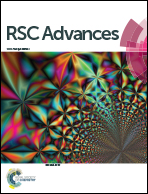Facile synthesis of Mn-doped hollow Fe2O3 nanospheres coated with polypyrrole as anodes for high-performance lithium-ion batteries
Abstract
Mn-doped Fe2O3/PPy hollow composite nanospheres were fabricated by a facile solvothermal method. The Mn–Fe2O3/PPy electrode showed an improved electrochemical performance in terms of high rate capability and long cycling performance compared with Fe2O3 without Mn doping and PPy coating. At current densities of 500 mA g−1 and 1000 mA g−1, the Mn–Fe2O3/PPy exhibited an initial capacity of 1214.7 and 924.9 mA h g−1, and the capacity was maintained at 795.7 and 643.6 mA h g−1 after 200 cycles.


 Please wait while we load your content...
Please wait while we load your content...